This article was last updated on April 16, 2022
Canada: ![]() Oye! Times readers Get FREE $30 to spend on Amazon, Walmart…
Oye! Times readers Get FREE $30 to spend on Amazon, Walmart…
USA: ![]() Oye! Times readers Get FREE $30 to spend on Amazon, Walmart…
Oye! Times readers Get FREE $30 to spend on Amazon, Walmart…
There are many components to America's GDP, the most important measure of economic health. These components include:
1.) Personal consumption which includes both goods and services. Goods include durable goods like automobiles and appliances and non-durable goods like food, clothing and fuel. Services include things like banking and health care.
2.) Business investment includes purchases that companies make to produce consumer goods but excludes business purchases that are made to replace an existing item. Business investments can be divided into two components; fixed investment and change in private inventory. Fixed investment consists primarily of business equipment such as machinery, computer systems and commercial buildings. Fixed investment also includes investments in residential construction including condominiums and single family homes. The second component, inventories, measures how much businesses order to increase the inventories of goods that they will sell in the future.
Inventories are obviously a very important part of the economy and can be used as a leading indicator since businesses will cut back on inventories as demand for their products slackens and increase inventories as demand for their products increase. Here is a graph from FRED showing how business inventory levels rise during economic expansions and fall during economic contractions:
During the Great Recession, total business inventories plunged from a peak of $1.54 trillion to $1.31 trillion, a decline of 15 percent. Since their low point, inventories have risen to their current level of $1.814 trillion.
Now let's look at the percentage change in inventories on a year-over-year basis:
This graph very clearly shows the impact of the Great Recession on America's business sector; during 2009, inventories fell by as much as 14.5 percent on a year-over-year basis as America's consumers slashed spending. After the inventory contractions during and immediately after the Great Recession, America's businesses began to rapidly add to inventories as they saw consumer demand for their products rise; by May 2011, inventories rose by a maximum of 11.9 percent on a year-over-year basis. This is the fastest inventory growth rate since 1992. That said, there is a note of caution as shown in this closeup of the same graph:
As you can clearly see, the year-over-year inventory growth rate has dropped from its post-Great Recession high of 11.9 percent in May 2011 to its current rate of 2.04 percent, its lowest level since July 2010.
Why is this? This graph which shows business inventory-to-sales ratio may answer the question for us:
Please keep in mind that the long period of dropping inventory-to-sales ratio during the 1990s and early 2000s was due to increased efficiencies in the corporate supply chains. By using the just-in-time inventory method as opposed to the formerly used just-in-case method, manufacturers were able to scale back the size of their inventories. If the switch to just-in-time inventory is removed from the equation, we can see that the current inventory-to-sales ratio is quite high for a non-recessionary period.
Here's a closeup showing the period since the beginning of the Great Recession:
The current business inventory-to-sales ratio is the highest that it has been since the Great Recession saw inventories rise as sales fell. In fact, it is tied for the highest level since April 2003. The inventory-to-sales ratio has been rising since the fourth quarter of 2014 and is showing no real sign of slowing down. Obviously, as we noted above, the rate of inventory growth has slowed down significantly so we can't blame a rising inventory-to-sales ratio on rising inventories. It therefore appears that the rise in the inventory-to-sales ratio should be blamed on dropping sales.
Since the Federal Reserve measures the inventory-to-sales ratio for three sectors of the economy, let's look at all three to see where the problem lies. First up, the retail sector:
The inventory-to-sales ratio for the retail sector has shown a slow and steady rise since it bottomed in early 2012.
Now, the manufacturing sector:
Once again, the inventory-to-sales ratio for the manufacturing sector has shown a very slow and steady rise since it bottomed in early 2011.
Lastly, here's the merchant wholesaler sector:
That's obviously where the problem lies. Merchant wholesalers operate between the manufacturer and the retail merchant. These wholesalers buy directly from the manufacturer and then sell at a profit to your local retailer. Colloquially, they would be called "middle men". From FRED, we can see that America's merchant wholesalers are seeing sales fall, leaving them with higher inventories of goods that retailers are unwilling to take from their warehouses.
What is all of this data telling us? Generally, as you can see from the long-term business inventory-to-sales ratio graph, a rising ratio indicates a slowing economy. Given that most American companies now rely on the just-in-time inventory model, it would appear that American consumers are increasingly happy to leave inventory sitting in Corporate America's merchant wholesalers' warehouses, a concerning sign for an economy that relies on consumer spending as its economic engine.
Click HERE to read more of Glen Asher's columns
You can publish this article on your website as long as you provide a link back to this page.

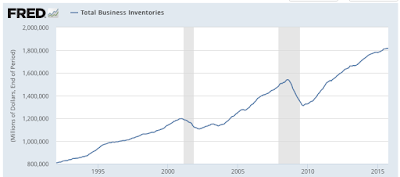
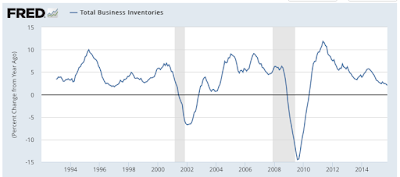
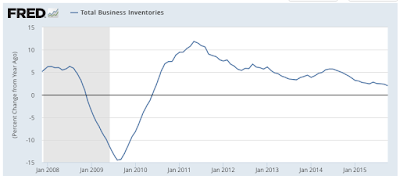
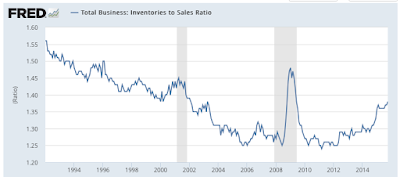
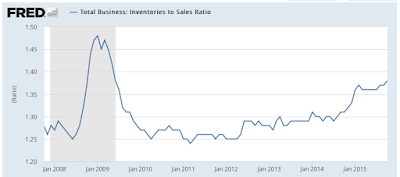

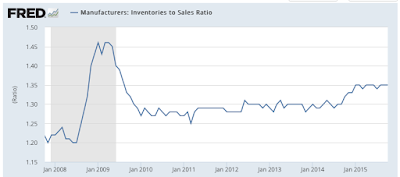
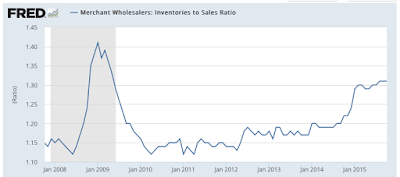
Be the first to comment